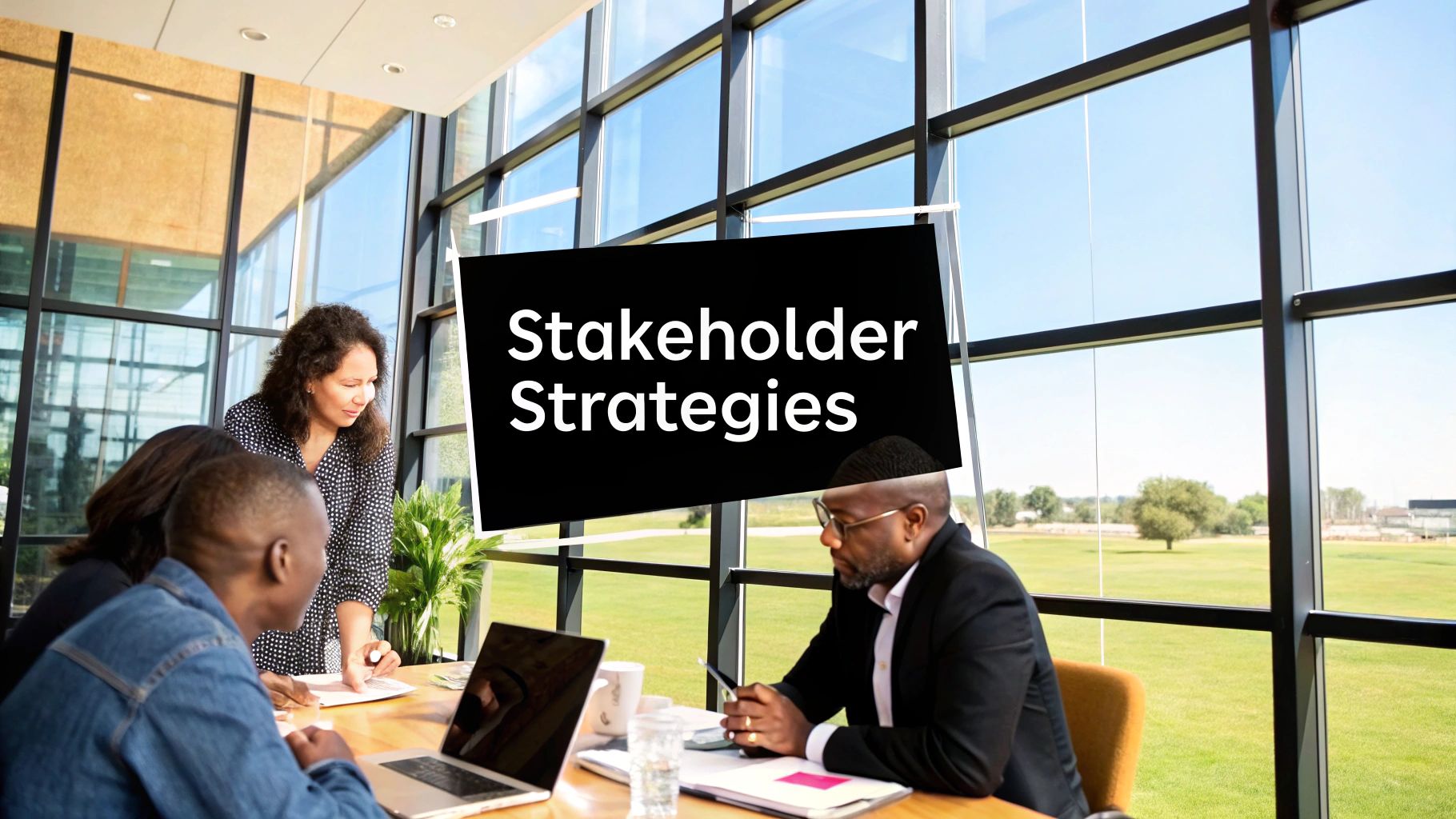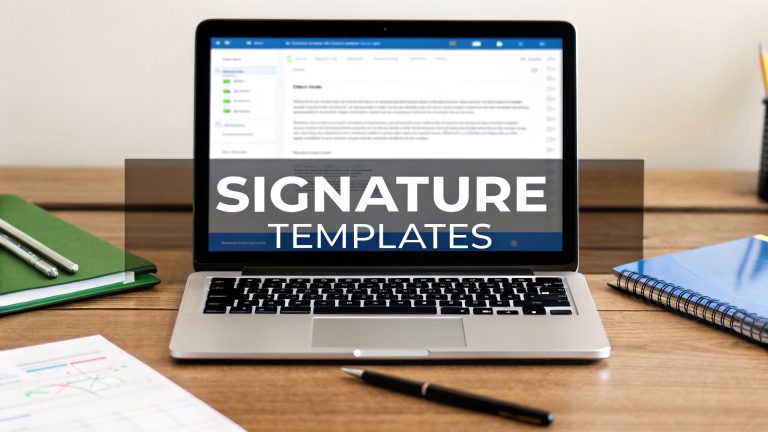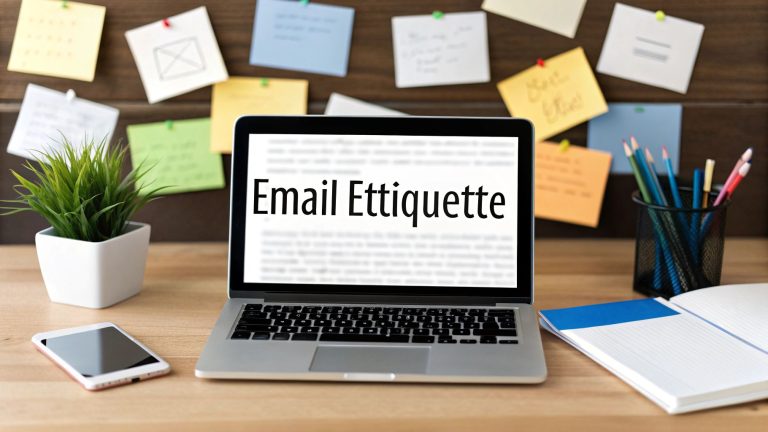In today's interconnected world, success is no longer a solo act. It's a collaborative performance where every stakeholder, from customers and employees to investors and community members, plays a crucial role. But how do you move from simply managing these groups to genuinely engaging them? The answer lies in effective stakeholder engagement strategies, which are the key to unlocking shared value, mitigating risks, and building lasting trust.
This guide goes beyond theory. We will provide ten actionable, field-tested strategies you can implement immediately to transform your professional relationships, drive innovation, and ensure your projects and organization thrive. Whether you are leading a small team or a multinational corporation, these proven approaches will help you build the strong, collaborative foundation needed for sustainable success.
For instance, managing formal communications, such as sending out inquiry letters or formal invitations, is a key part of many of these strategies. A tool like an AI Letter Generator can streamline this process, ensuring your outreach is professional and efficient. This frees up your time for more direct, meaningful engagement activities. Let’s dive into the specific methods that turn stakeholders into true partners.
1. Stakeholder Mapping and Analysis
Before you can engage stakeholders, you must first know who they are and what they care about. This foundational step is crucial for developing effective stakeholder engagement strategies. Stakeholder mapping is a systematic process of identifying all individuals, groups, or organizations that can impact or be impacted by your project and analyzing their influence and interest. This clarity allows you to allocate resources efficiently and tailor your communication for maximum impact.
How It Works
The most common tool for this is the Power/Interest Matrix. This simple grid helps you categorize stakeholders into four key groups:
- High Power, High Interest (Manage Closely): These are key players. Fully engage them and make the greatest efforts to satisfy their needs.
- High Power, Low Interest (Keep Satisfied): Put enough work in to keep them happy, but not so much that they become bored with your messaging.
- Low Power, High Interest (Keep Informed): Adequately inform these individuals and talk to them to ensure no major issues are arising.
- Low Power, Low Interest (Monitor): Monitor this group, but do not bombard them with excessive communication.
Implementation Tips
- Involve Cross-Functional Teams: Bring together people from different departments to brainstorm a comprehensive list of stakeholders. A sales team member might identify a key customer group the engineering team overlooks.
- Update Regularly: Stakeholder positions and interests change. Revisit your map quarterly or at key project milestones to ensure it remains accurate.
- Document Interactions: Keep a record of past communications, concerns, and feedback. This history provides valuable context for future engagement.
- Go Beyond the Obvious: Think about secondary or tertiary stakeholders, such as regulatory bodies, community groups, or media outlets, who could indirectly influence your project.
2. Two-Way Communication and Dialogue
Effective stakeholder engagement strategies move beyond one-way announcements to create genuine dialogue. This approach prioritizes listening as much as speaking, building a relationship based on trust and mutual respect. Instead of simply informing stakeholders, two-way communication involves them in the decision-making process, ensuring their concerns and insights are heard, valued, and integrated into the project's direction. This collaborative process transforms stakeholders from passive recipients into active partners.

How It Works
Two-way communication creates channels for feedback and response, closing the loop between the organization and its stakeholders. This can take many forms, from formal consultation processes to informal conversations.
- Feedback Mechanisms: Organizations actively solicit input through surveys, town halls, community forums, or customer advisory boards.
- Responsive Action: The organization doesn’t just collect feedback; it analyzes it, acknowledges it, and demonstrates how that input influenced decisions or policies.
- Continuous Conversation: The dialogue is ongoing, not a one-time event. It adapts as the project evolves and stakeholder needs change.
Implementation Tips
- Create Psychological Safety: Foster an environment where stakeholders feel safe to share honest, critical feedback without fear of negative consequences.
- Use Diverse Channels: Reach stakeholders where they are. Combine digital platforms like social media and email with in-person meetings and workshops to ensure broad participation.
- Show, Don't Just Tell: Visibly demonstrate how stakeholder input led to specific changes. Acknowledge their contribution publicly to build trust and encourage future engagement. For further details on this, explore these client communication best practices.
- Train for Empathy: Equip your team with active listening skills. To ensure effective and empathetic communication with a crucial stakeholder group like customers, consider approaches for mastering customer service and empathy.
3. Collaborative Problem-Solving and Co-Creation
Moving beyond simply informing or consulting stakeholders, this advanced strategy invites them to become active partners in the problem-solving and solution-building process. Co-creation transforms stakeholders from a passive audience into valued collaborators, fostering a deep sense of ownership and commitment. By working together to innovate, you can generate more robust, user-centric, and widely accepted outcomes, making it one of the most powerful stakeholder engagement strategies available.
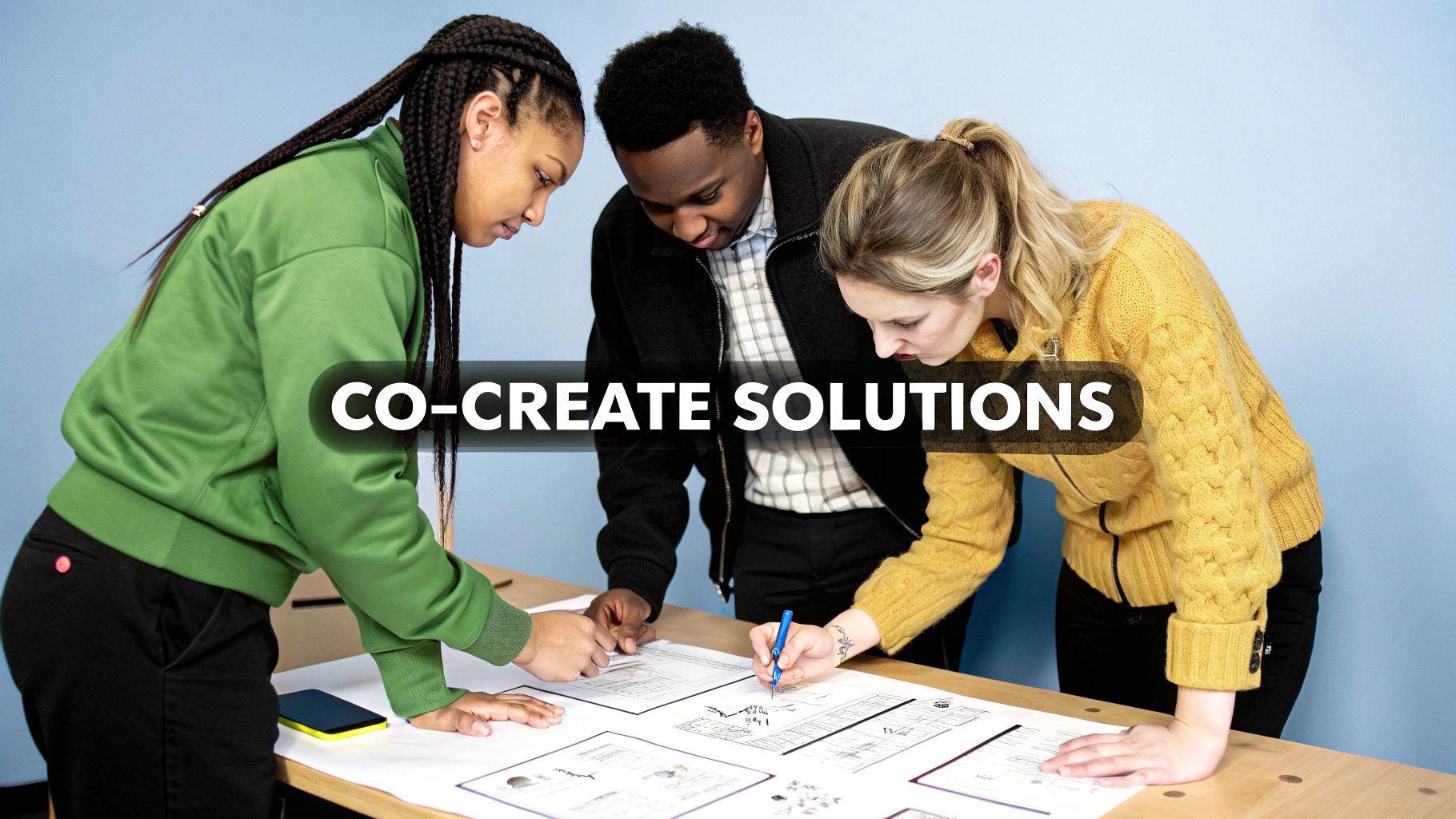
How It Works
This approach involves bringing diverse stakeholder groups, such as customers, employees, suppliers, and community members, into a structured, creative process. Facilitated workshops, design sprints, and participatory forums are common methods. The goal is to leverage collective intelligence to address complex challenges or develop new products and services. For instance, a software company might run a design sprint with end-users to refine a new feature, ensuring the final product genuinely meets their needs and expectations.
Implementation Tips
- Use Structured Frameworks: Employ proven methodologies like Design Thinking, World Café, or Open Space Technology to guide the collaborative process and ensure productive discussions.
- Ensure Diverse Representation: Intentionally include stakeholders with different perspectives, backgrounds, and expertise to enrich the problem-solving process and avoid groupthink.
- Establish Clear Parameters: Set clear goals, constraints, and decision-making authority from the start. Let participants know how their input will be used to manage expectations.
- Acknowledge All Contributions: Document ideas and feedback carefully, crediting participants for their contributions. This validation encourages continued engagement and builds trust.
- Communicate Outcomes: Close the feedback loop by sharing the final decisions and explaining how stakeholder input directly shaped the outcome. This transparency is crucial for maintaining long-term relationships. Exploring how to present these outcomes effectively in a formal context can be explored further in various business proposal letter samples.
4. Transparency and Information Sharing
Trust is the foundation of any successful relationship, and the same holds true for stakeholder engagement. Transparency and information sharing are fundamental stakeholder engagement strategies that build this trust by providing access to timely, accurate, and relevant information. When stakeholders feel they have the full picture, it reduces speculation, counters misinformation, and fosters a collaborative environment where issues can be addressed openly. This approach transforms stakeholders from passive observers into active, informed partners.
How It Works
This strategy involves proactively communicating about organizational decisions, performance, plans, and even challenges. Instead of waiting for stakeholders to ask questions, you provide the answers upfront. This can take many forms, from detailed sustainability reports like those using the Global Reporting Initiative (GRI) framework to open forums about project hurdles. Patagonia, for instance, practices radical transparency by openly discussing its supply chain issues, which strengthens its credibility with environmentally-conscious customers. This honesty builds a reservoir of goodwill that is invaluable during difficult times.
Implementation Tips
- Establish a Communication Cadence: Create a predictable schedule for updates, such as weekly project newsletters, quarterly town halls, or annual reports, so stakeholders know when to expect information.
- Use Multiple Channels: Share information through various platforms to reach different stakeholder groups, including dedicated web portals, social media updates, email digests, and in-person meetings.
- Be Honest About Challenges: Don’t just share the wins. Being transparent about setbacks and uncertainties shows respect for your stakeholders and can often lead to them offering valuable support or solutions.
- Simplify Complexity: Translate technical jargon, complex data, and internal metrics into clear, stakeholder-relevant terms. Use visualizations like charts and infographics to make information more accessible and digestible.
5. Formal Advisory Boards and Councils
For long-term projects or ongoing organizational governance, establishing a formal advisory board is a powerful stakeholder engagement strategy. This approach institutionalizes stakeholder participation by creating a structured group of representatives who meet regularly to provide guidance, strategic insight, and feedback. It signals a deep, long-term commitment to including stakeholder voices in core decision-making processes, moving beyond ad-hoc consultations to a formal partnership.
How It Works
An advisory board or council is a dedicated body of selected stakeholders given a formal (though typically non-binding) role in influencing an organization or project. Unlike a board of directors, their role is to advise rather than govern. This structure is ideal for specialized input, such as a tech company creating an AI Ethics Council with external experts or a university forming a Community Advisory Board to guide local development projects. These bodies follow a defined charter and meeting schedule to ensure consistent, high-level engagement.
Implementation Tips
- Define a Clear Charter: Create a document outlining the board's purpose, scope, authority, and responsibilities. This prevents ambiguity and manages expectations from the start.
- Ensure Genuine Influence: The board's recommendations must be formally considered and acted upon. If the role is purely symbolic, it will quickly lead to disengagement and cynicism.
- Provide Proper Onboarding: Equip new members with the necessary context, data, and training to contribute effectively. This ensures they can provide valuable and informed advice.
- Rotate Membership: Periodically bring in new members to introduce fresh perspectives and prevent groupthink. This also expands your network of engaged stakeholders. You can find guidance on how to properly invite new members on formal invitation letter examples.
- Compensate Fairly: Acknowledge the significant time and expertise advisors contribute by offering appropriate compensation, whether through stipends, honorariums, or other benefits.
6. Community Engagement and Outreach Programs
Beyond the boardroom, effective stakeholder engagement strategies often involve building genuine relationships with the wider community. Community engagement and outreach programs are proactive initiatives designed to connect with local populations, build goodwill, and demonstrate social responsibility. By moving beyond transactional relationships, organizations can create a loyal base of support, gain valuable local insights, and establish a positive brand presence that resonates on a human level.
How It Works
This strategy focuses on creating shared value through direct, long-term interaction. Instead of just communicating to the community, you engage with it. The goal is to listen, learn, and contribute in meaningful ways that align with both community needs and your organization's mission. These programs can take many forms:
- Partnership Initiatives: Collaborating with local non-profits, schools, or community groups on projects. For example, a tech company like Microsoft might offer coding workshops in local schools.
- Corporate Philanthropy: Direct financial support, grants, or in-kind donations to community causes, as seen in Bank of America's extensive philanthropic efforts.
- Employee Volunteerism: Encouraging and empowering staff to contribute their time and skills to local initiatives.
- Community Events: Sponsoring or hosting events that bring people together, such as festivals, clean-up days, or local workshops.
Implementation Tips
- Start with a Needs Assessment: Before launching a program, genuinely listen to the community. Conduct surveys, hold town halls, or partner with local leaders to understand their actual needs and concerns.
- Build Long-Term Partnerships: One-off events have limited impact. Focus on developing sustained relationships with trusted local organizations to create lasting change.
- Empower Employees: Create structured volunteer programs and give employees a voice in choosing the causes your organization supports. This boosts internal morale and external impact.
- Be Transparent: Clearly communicate your motivations and goals for community engagement. Authenticity is key to building trust and avoiding perceptions of self-serving behavior.
7. Digital Engagement Platforms and Social Media
In today's interconnected world, leveraging digital tools is no longer optional; it's a core component of effective stakeholder engagement strategies. Digital platforms and social media channels allow organizations to communicate in real-time, gather instant feedback, and build vibrant communities with stakeholders regardless of their physical location. This approach democratizes engagement, giving a voice to a broader audience and fostering a sense of transparency and accessibility.
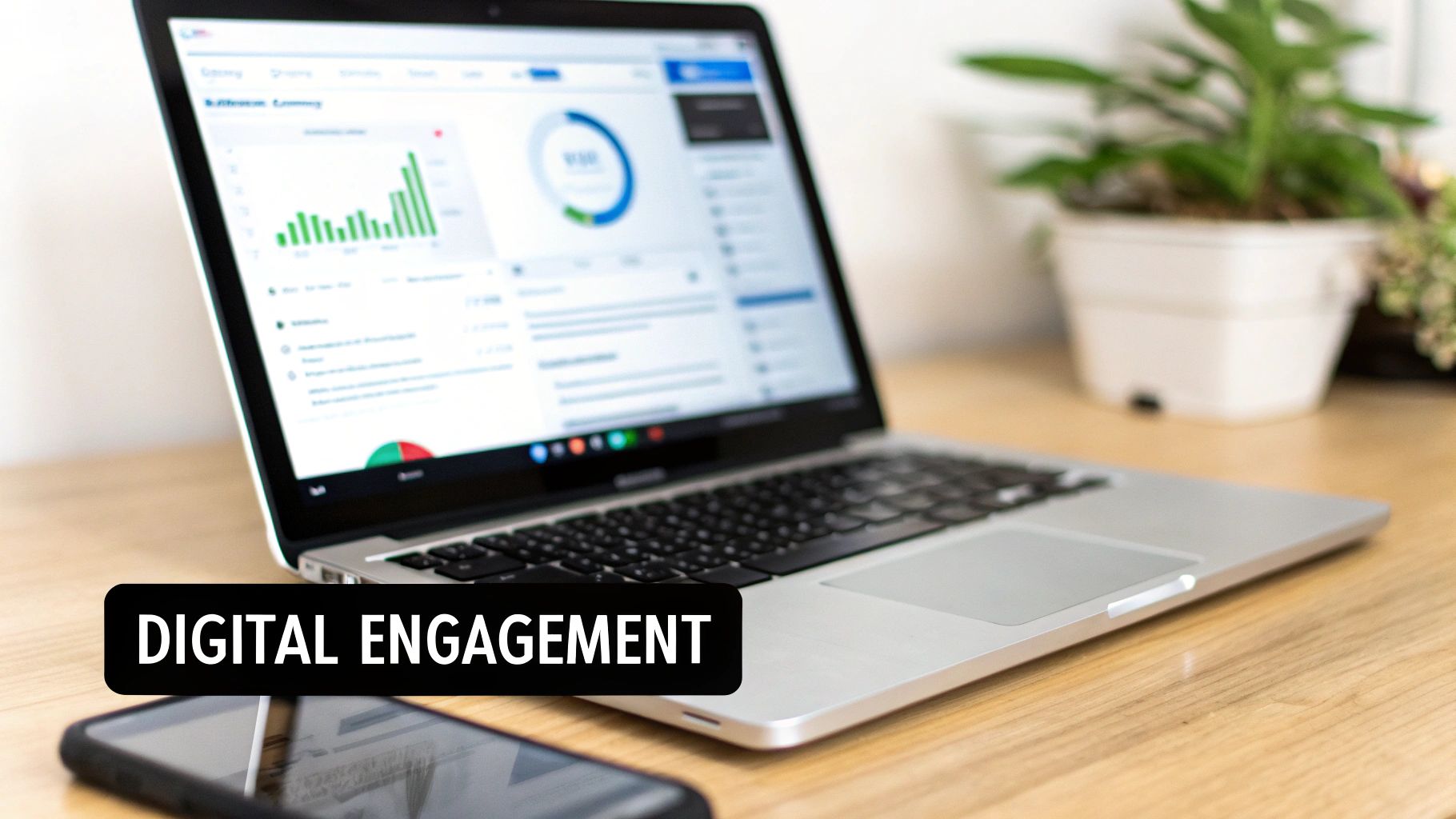
How It Works
This strategy involves using online platforms to share information, host discussions, and collect input. Instead of relying solely on traditional methods like town halls or newsletters, organizations can create a continuous, two-way dialogue. For example, a company can use a dedicated Slack channel for key customers to provide direct feedback, or a CEO can host a Reddit "Ask Me Anything" (AMA) to address public questions openly. These interactions build trust and demonstrate a commitment to listening.
Implementation Tips
- Establish Clear Guidelines: Create a social media policy that outlines the brand's voice, response protocols, and ethical standards to ensure consistent and professional interactions.
- Choose the Right Platforms: Don’t try to be everywhere. Focus your efforts on the channels where your key stakeholders are most active, whether it's LinkedIn for professionals or a Facebook Group for a local community.
- Balance Content: Mix promotional content with valuable, non-promotional information. Share industry insights, educational resources, or behind-the-scenes content to keep your audience engaged.
- Be Responsive and Authentic: Acknowledge comments and messages promptly, even if it's just to say you're looking into an issue. Authenticity is crucial for building genuine relationships online.
8. Stakeholder Grievance and Feedback Mechanisms
A proactive approach to stakeholder engagement involves creating formal systems to hear and address concerns. Stakeholder grievance and feedback mechanisms are structured processes designed to collect, document, and resolve stakeholder complaints and suggestions. Implementing these systems shows a commitment to accountability and continuous improvement, building trust and preventing minor issues from escalating into major crises.
How It Works
These mechanisms provide a clear, safe, and accessible channel for stakeholders to voice their concerns without fear of reprisal. The process typically involves several stages:
- Intake: Receiving a complaint or feedback through a designated channel (e.g., a hotline, web form, or dedicated office).
- Assessment & Triage: Acknowledging receipt and determining the issue's severity and the appropriate response path.
- Investigation & Resolution: Objectively investigating the claim and working toward a fair and timely resolution for all parties.
- Communication & Closure: Informing the stakeholder of the outcome and documenting the case for internal learning and reporting.
Implementation Tips
- Ensure Accessibility and Anonymity: Offer multiple channels for feedback that accommodate different languages, literacy levels, and technologies. Provide anonymous reporting options and enforce strict non-retaliation policies.
- Set Clear Timelines: Establish and communicate clear service level agreements for acknowledging receipt, providing updates, and resolving issues.
- Close the Feedback Loop: Always communicate the resolution or action taken back to the person who provided the feedback. This simple step demonstrates that their input is valued.
- Analyze Trends: Regularly review feedback data to identify systemic issues versus isolated incidents. Use these insights to inform strategic decisions and process improvements. For guidance on structuring formal complaints, you can find helpful resources on how to write a formal complaint letter.
9. Stakeholder Training and Capacity Building
A proactive and often overlooked stakeholder engagement strategy is to invest directly in your stakeholders' success. Instead of simply communicating with them, this approach focuses on building their skills, knowledge, and capabilities. By empowering stakeholders through training, you create more effective partners, informed advocates, and a stronger, more resilient ecosystem around your organization or project. This transforms the relationship from transactional to a true partnership.
How It Works
This strategy moves beyond information-sharing to active enablement. The goal is to equip stakeholders with the tools they need to succeed, aligning their growth with your own. This can take many forms, from formal certification programs to informal workshops. For example, a tech company might offer coding bootcamps to foster a skilled talent pool, or a manufacturer could run supplier development programs to improve supply chain quality and efficiency. The core idea is that a rising tide lifts all boats.
Implementation Tips
- Conduct a Needs Assessment: Before launching any program, survey your stakeholders to understand their knowledge gaps and what skills they value most.
- Offer Mixed Learning Modalities: Combine online, self-paced courses with in-person workshops to cater to different learning styles and schedules.
- Recognize and Credential: Provide certificates or digital badges upon completion. This validates their effort and gives them a tangible credential.
- Gather Feedback Continuously: Use surveys and focus groups to refine your training content and ensure it remains relevant and effective. For more formal communication, like sending out invitations or follow-ups, you might want to learn more about professional letter writing.
10. Performance Measurement and Impact Reporting
To sustain long-term buy-in and justify resources, you must demonstrate the value of your engagement efforts. Performance measurement is a strategic approach that systematically tracks, analyzes, and communicates the outcomes of your stakeholder engagement strategies. This evidence-based method moves beyond anecdotal feedback, building credibility and proving that your initiatives are delivering tangible results, which is essential for securing ongoing investment and support.
How It Works
This strategy involves defining what success looks like and then collecting data to prove it. It connects your engagement activities directly to business or project objectives. Common frameworks include:
- Balanced Scorecard: Incorporate stakeholder-centric metrics (like satisfaction or trust) alongside traditional financial and operational KPIs.
- Net Promoter Score (NPS): Adapt this customer loyalty metric to gauge stakeholder willingness to support or recommend your project.
- Sustainability Reporting: Use standards like GRI (Global Reporting Initiative) to report on stakeholder engagement activities and their social or environmental impact.
Implementation Tips
- Define Clear Outcomes: Start with a logic model that maps engagement activities to specific short-term outputs and long-term impacts.
- Establish Baselines: Before launching a new initiative, measure your starting point. This provides a clear benchmark for assessing progress.
- Use a Mix of Metrics: Combine quantitative data (e.g., survey scores, attendance rates) with qualitative insights (e.g., interview feedback, testimonials).
- Report Transparently: Share your findings, both successes and areas for improvement, with stakeholders. This transparency builds trust and accountability. To genuinely understand the value of your engagement efforts, especially training initiatives, it's vital to know how to measure training effectiveness through clear ROI metrics.
Stakeholder Engagement: 10-Point Strategy Comparison
| Strategy | Implementation complexity | Resource requirements | Expected outcomes | Ideal use cases | Key advantages |
|---|---|---|---|---|---|
| Stakeholder Mapping and Analysis | Medium — systematic, ongoing updates required | Low–Medium — workshops, analytics, visualization tools, cross‑functional time | Prioritized stakeholder list, targeted engagement plans, early conflict identification | New projects, large initiatives, prioritizing engagement efforts | Clear prioritization, reduces wasted effort, enables targeted communication |
| Two‑Way Communication and Dialogue | High — continuous facilitation and management | High — skilled facilitators, forums, follow‑up systems, time | Increased trust, better-informed decisions, higher stakeholder buy‑in | Policy changes, contentious issues, relationship building | Builds trust, surfaces concerns early, improves decision quality |
| Collaborative Problem‑Solving and Co‑Creation | High — iterative and facilitation‑heavy | High — participatory workshops, stakeholder time, facilitation tools | Feasible co‑owned solutions, stronger commitment, reduced resistance | Product/service design, complex multi‑stakeholder challenges | Leverages collective intelligence, creates shared ownership |
| Transparency and Information Sharing | Medium — requires data systems and clear communication | Medium–High — reporting systems, data management, translation/formatting | Greater credibility, reduced misinformation, accountability | Regulatory reporting, investor/community trust building | Builds trust and accountability, attracts conscious partners |
| Formal Advisory Boards and Councils | High — governance design and political management | High — member recruitment, admin support, compensation | Regular expert input, oversight, perceived legitimacy | Long‑term strategy, corporate governance, ethics oversight | Consistent touchpoints, external perspectives, governance credibility |
| Community Engagement and Outreach Programs | Medium — sustained program management | Medium–High — funding, staff, events, partnerships | Local goodwill, community insights, enhanced reputation | CSR initiatives, local project rollouts, community relations | Builds local relationships, creates social impact, engages employees |
| Digital Engagement Platforms and Social Media | Medium — ongoing monitoring and rapid response | Medium — platforms, moderation, analytics, content creation | Broad reach, real‑time feedback, measurable engagement metrics | Geographically dispersed stakeholders, mass communications | Scalable, cost‑effective, provides quantifiable metrics |
| Stakeholder Grievance and Feedback Mechanisms | Medium — process design and escalation systems | Medium — multiple channels, case management, trained staff | Early issue detection, resolved complaints, legal/operational risk reduction | High‑risk projects, customer service, rights‑sensitive contexts | Prevents escalation, documents responses, builds trust |
| Stakeholder Training and Capacity Building | Medium–High — program design and delivery | High — curriculum development, trainers, time and facilities | More capable stakeholders, higher quality input, long‑term relationships | Supplier development, partner ecosystems, community capacity building | Strengthens partners, improves participation quality, fosters loyalty |
| Performance Measurement and Impact Reporting | High — metrics, baselines, data systems | High — surveys, analytics, reporting frameworks, benchmarking | Evidence of engagement value, accountability, data‑driven improvements | Demonstrating ROI, securing funding, meeting reporting standards | Justifies investment, enables continuous improvement, transparency |
Putting Your Plan into Action: The Path Forward
We've explored ten powerful stakeholder engagement strategies, from the foundational work of Stakeholder Mapping and Analysis to the essential accountability of Performance Measurement and Impact Reporting. Each strategy serves as a vital tool in building strong, productive, and lasting relationships. But remember, a toolkit is only as effective as the person using it. True success isn't about implementing all ten strategies at once; it's about thoughtfully selecting and integrating the right ones for your unique context.
The journey from viewing stakeholders as an audience to treating them as partners is a transformative one. It shifts your organization’s focus from simply managing perceptions to actively building trust and fostering mutual growth. This commitment to genuine dialogue, transparency, and collaboration is what separates leading organizations from the rest.
Your Actionable Next Steps
To move from theory to practice, don't let this list remain just a list. The most effective stakeholder engagement strategies are those that are actively and consistently applied.
Here’s a simple, three-step plan to get started:
- Start with Clarity: Revisit Strategy #1, Stakeholder Mapping and Analysis. If you haven’t already, dedicate time to clearly identify who your stakeholders are, what they care about, and how much influence they have. This single exercise will provide the clarity needed to inform every subsequent action.
- Pick Your Priority: Based on your mapping, choose one or two strategies that address your most pressing need. Is there a lack of trust? Focus on Transparency and Information Sharing or implementing a robust Grievance and Feedback Mechanism. Do you need innovative ideas? Prioritize Collaborative Problem-Solving and Co-Creation. A small, focused start is far more effective than a broad, shallow effort.
- Commit to Consistency: Stakeholder engagement is not a one-time campaign. It's an ongoing practice. Schedule regular check-ins, commit to consistent communication, and make engagement a core part of your operational rhythm.
The Lasting Impact of Effective Engagement
Mastering these approaches does more than just improve relationships. It builds organizational resilience, fuels innovation, and solidifies your reputation. When stakeholders feel heard, valued, and included, they become powerful advocates and allies. They will champion your mission, provide critical feedback to help you avoid pitfalls, and co-create solutions that drive sustainable success.
By weaving these principles into the fabric of your organization, you are not just managing risk; you are unlocking your greatest strategic asset. You are building a future where your success is shared, celebrated, and sustained by the very people your work impacts.
Ready to enhance your communication and implement these strategies effectively? The AI Letter Generator can help you craft clear, professional, and tailored correspondence for every stakeholder interaction, from formal invitations to advisory boards to transparent project updates. Save time and ensure every message hits the right note. Try the AI Letter Generator today and elevate your engagement.
